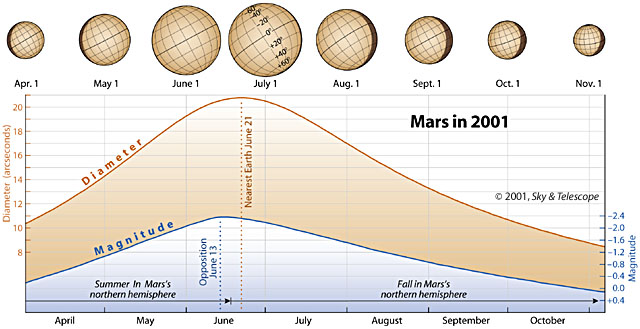
Approximately every 26 months, Mars comes to opposition. This is when the bodies Sun-Earth-Mars lie in a straight line (with the Earth in the middle) and is the time when Mars is closest to Earth. Therefore, this is when Mars appears to be its brightest and largest. Opposition this year occurs on June 13, 2001 and Mars is at its closest on June 21, 2001 when it is at a distance of 67 million kilometers.
Mars is hard to see in any detail, except at opposition. Even then, fine detail may be difficult to see. The nearness of Mars at opposition goes through a 15 year cycle. We are currently in the upswing of such a cycle. This year, Mars reaches a largest apparent size of 20.5 arcseconds in diameter (the best opposition of this cycle occurs on August 27, 2003 when it will have an apparent diameter of 25 arcseconds). Here is a graph of the apparent size and magnitude of Mars this year (from Sky and Telescope, May 2001):

It takes a lot of patience to see detail on Mars. The quality of image is affected by the stillness of Earth's atmosphere, the altitude of Mars in the sky, and the activity in Mars' atmosphere (namely, clouds and dust storms). The best way to observe Mars is to watch for long periods of time while you wait for a glimpse through steady air. Through an 8 inch telescope (such as those here at the ETSU observatory), you should expect to see dark surface markings and the north polar cap. You might also see limb haze and occasional white clouds or dust storms. Here's a map of the features visible through a small telescope (from Sky and Telescope, May 2001):
